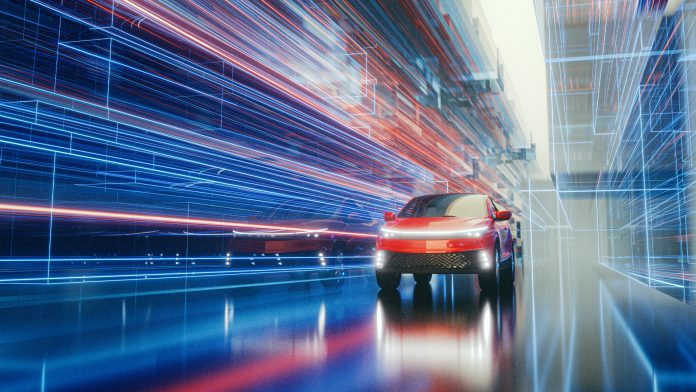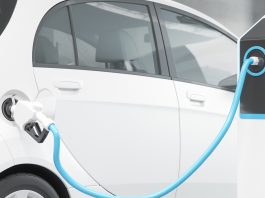Focusing on EV battery technology optimisation misses the point, says ElectReon. Here, the company explains why we need to rethink EV charging technology to achieve net zero emissions.
Emissions from transport make up a significant percentage of pollution that is causing world temperatures to rise. In 2010, transport made up 17% of worldwide emissions, with 95% of those emissions coming from petroleum-based fuels.1 Jump forward ten years and transport – specifically fuel combustion – is responsible for 24% of direct CO2 emissions worldwide, and it is growing. Of the 455 MtCO2e of greenhouse gas (GHG) emissions produced by the UK in 2019, transport was responsible for 27%.2
In order to arrive at net zero emissions, we need to replace the 1.4 billion vehicles that rely on petroleum with electric vehicles (EVs) that can outperform or at least match internal combustion engine (ICE) performance.3 EV uptake is happening and, despite COVID-19 causing ICE car sales to falter, sales for electric cars grew by over 40% in 2020, mostly due to policy support and stimulus measures in the EU and China respectively.4
More than 24 countries and territories have set dates on which the sale of new ICE vehicles will be prohibited.5 However, passenger vehicles are not the only problem: combined with HGVs, buses and two and three-wheeled vehicles are responsible for almost 75% of all CO2 emissions from all transport modes.6 Substantial changes to facilitate the shift to EVs must be made, including for fleet operators of commercial vehicles and public transport.
Under current trends, replacing all ICE vehicles with battery-operated alternatives is simply not feasible as we do not have the resources to produce so many large capacity batteries to counter range anxiety. Taking into account the finite and expensive raw materials required to manufacture lithium-ion batteries, carbon emissions associated with EV production can be between 38% and 74% more than ICE vehicles.7
It is understandable, therefore, why strategies to optimise battery technology are commonly the focal point of EV technology innovation. However, the automotive industry seems determined to focus on optimising current EV battery systems without addressing the bigger hurdle; our current plug-in charging solutions are not optimised, sustainable, or scaleable enough to meet climate change targets. Battery optimisation can likely be improved by a factor of three, suggests Bill Gates, who has highlighted that we would need an improvement of a factor of 50 to have the substantial emissions reduction impact desperately required.8
Existing plug-in charging technology limit fleet operations
It is understandable that most technological innovations have focused on EV battery development, optimisation, and management in recent years. There have been very few technological advancements in conductive (wireless) charging for electric vehicles, and so many fleet operators who have wanted to make a shift towards electric fleets have had only conductive charging solutions to choose from, which come with many barriers.
While the technology is a step towards fewer emissions, the limitations are substantial. The high Total Cost of Ownership (ToC) is the deciding factor for fleet owners shifting to EVs. Fleet operators must purchase a more expensive fleet compared to diesel or gas fleets, and require heavy EV charging infrastructure with enough land on their facilities to house the fleet during a charging session.
In reality, this location would be outside of city centres and urban locations, for three reasons. Land is cheaper beyond city limits, infrastructure for charging is unsightly and does not tend to fit the aesthetics of green cities, and finally, pressures on the grid caused by mass EV charging technology can be better managed outside of peak demand areas. Grid upgrades and charging infrastructure maintenance, which are expensive capital and ongoing investments, are more easily managed away from the hustle and bustle of urban centres.
On the ground, drivers must manually plug-in the vehicles to charge and fleet operators lose active operational hours to the required downtime spent charging EV batteries. Conductive charging is not friendly to people with disabilities and does not offer charging compatibility with the anticipated shift to autonomous vehicles (AVs). The bottom line is that high investment and required changes to fleet operations and workflows are the predominant deterrent to EV uptake for fleet owners.
Switching the focus from batteries to EV charging technology and infrastructure
In 2013, ElectReon began developing its Wireless Power Transfer (WPT) technology to charge vehicles as they drive, which is now recognised as a wireless Electric Road System (ERS); a road retro-fitted with copper coils. The technology charges vehicles at multiple speeds, including when they are stopped, and can be fitted anywhere; along sections of regular bus routes, motorways, toll roads, bus stops, taxi lanes, under loading bays, and at traffic lights. EVs are fitted with an authorised receiver to enable charging to take place as they park or drive over the in-road technology.
Pilots for this new EV charging technology have shown that vehicles such as e-buses can operate uninterrupted and on batteries that are up to 90% smaller than those required to support the same e-bus powered only by an overnight conductive charging solution. Range anxiety, a bona fide phenomenon for some bus fleet operators and drivers that have already begun shifting to electric, has also been eradicated with wireless charging, which provides range extension. During several company pilots, drivers have expressed confidence that their vehicles remained substantially charged and were continuously delivering a service without threatening to run out of power before reaching the depot at the end of the day.
Charging infrastructure for wireless systems can be more cost-effective than conductive options for fleet owners; ongoing company pilots and analyses have demonstrated a potential cost saving of 30% to 50% from a multitude of factors. Lower vehicle costs from reducing battery capacity, lower grid connection costs as energy demand for charging is spread temporally and spatially throughout the operational hours of the fleet, and specifically to ElectReon’s architecture. Dozens of vehicles can charge simultaneously from the same system, offering an economical approach to scaling-up e-fleets.
Wireless EV charging technology impacts driver behaviour
Drivers of private vehicles and fleet-operated vehicles are typically used to accessible fuelling stations along their routes and at their destination. Installation of plug-in charging points across fuel stations is already underway in many leading markets9, but establishing EV charging solutions across an archaic ICE fuelling infrastructure is counterintuitive as it encourages old behaviours of queuing to fuel up, normalising range limitation, and planning routes that take into consideration and even prioritise journey stops to fuel up.
Invisible wireless vehicle charging offers a complete overhaul of old fuelling habits; petrol forecourts can be reclaimed as green spaces serving retail or relaxation needs for travellers and could be offered as additional sites to plant trees to assist governments in achieving carbon emissions targets. Queues for charging can be eliminated and range limitation would be rarely considered as range-extending wireless charging seamlessly occurs in the background.
Research suggests a battery’s state of charge (SoC) should remain between 30% and 80% to reduce battery degradation.10 Frequent top-up charging patterns, facilitated by both wireless electric roads and wireless charging stations installed in fleet operational areas, enable this healthy SoC range to be maintained. On the other hand, typical conductive charging schedules see battery depletion to below 20% before a full charge, usually overnight, and for much longer periods of time.
Wireless charging zones are also largely invisible, with no external charging infrastructure trailing above or alongside roadways. City centres that are heavily pedestrianised or plan to prioritise walking and cycle paths can endorse wireless charging for EVs, without health risks to pedestrians walking over wireless charging zones or vandalism to charging property; everything is buried safely below ground.
The technology
Copper coils installed beneath the road or paved area surface are powered by a management unit as part of ElectReon’s system, which is connected to the grid or distributed renewable energy sources. Deploying one mile of the technology today takes as little as one night and can be easily planned to coincide with other engineering roadworks as installation is fairly simple. The top layer of asphalt is scraped off, the coils are placed on the ground, and a new asphalt layer is laid. The company is working on scaling-up its deployment processes.
For fleet operators who have existing depot setups, the wireless charging system is ideal for installation at these locations. A commercial facility housing hundreds of vehicles can have wireless charging technology deployed in a single night in the same style as a public road. Once the technology is installed, there is no interference with road quality or reduction in road durability. One of the company’s first-generation systems was deployed under a road in Tel Aviv in 2015 as part of the company’s research and monitoring programme and no road surface changes have been observed since.
The technology is designed to be modular and scaleable; any length of wireless ERS can be deployed in public and private spaces as the EV charging technology is completely inactive until an authorised EV passes over the charging zone or is parked above it. On the vehicle itself, the technology is built to easily retrofit onto existing models aftermarket, in accordance with any vehicle or battery requirements. ElectReon is the first company to integrate its patented technology with a bus, a truck, and passenger EVs and is currently integrating with an e-van.
Eight global auto manufacturers have already participated in trials and pilots including Renault, Stellantis, Volkswagen, and Iveco. Vehicle receivers are fitted to a vehicle and can transfer varying amounts of energy, depending on the vehicle energy requirement. For example, passenger vehicles equipped with one receiver can receive 25-30kW, whereas an HGV can be equipped with up to seven receivers to support a transfer of up to 210kW of power today. We expect to incrementally increase the system capacity to transfer power in each new vehicle receiver generation.
Wireless charging offers the possibility of significantly reducing the battery capacity required for an electric HGV, when powered by inductive opportunity charging, instead of conductive plug-in charging for example. This is due to wireless opportunity charging’s ability to reduce the need to carry larger, heavier, and, therefore, more expensive batteries that carry more energy throughout the day. In terms of potential cost and weight savings, if we estimate an electric HGV’s average required battery size to be 600kWh and use the upcoming Tesla Semi as a case example, simply reducing the vehicle’s required battery capacity to 300kWh could result in $50,000 to $60,000 in battery cost savings and two tonnes in payload savings per Semi.11
Charging multiple vehicles from a single wireless Electric Road System
Scalability of this technology has been proven with a pilot in Gotland, Sweden, where an e-bus and e-truck were charged by the same ERS simultaneously whilst driving. The pilot, funded by the Swedish government, is one of several government and OEM collaboration projects that test wireless EV charging viability across several vehicle models and transportation locations and services. To date, five projects on public roads are currently live in Sweden, Germany, Italy, and Israel.
In Sweden, a 1.6km (~1 mile) long wireless electric road was built to charge vehicles operating a route of 4.1km (~2.5 miles) between the town of Visby and the airport on Gotland Island. An e-bus now serves the public and an e-truck is being tested by a commercial HGV driver. The success of this pilot project is expected to lead to further ERS rollouts across motorways in Sweden. The 40-tonne e-truck has been equipped with a 210kWh capacity battery, a much smaller capacity compared to typical e-HGV battery sizes of 500kWh to 700kWh. A reduction in battery capacity not only saves e-truck operators in battery costs, it also increases operational payload. Data from the pilot in Sweden showed that e-truck battery capacity offered extended range opportunities for e-trucks powered by wireless charging infrastructure at scale.
In Israel, our pilot project took place in Tel Aviv, where a 12-metre urban e-bus was fitted with receivers and charging occurs both from a wireless charging station at the bus terminal and from a 700-metre stretch of electric road. The bus runs on a circular route totalling 5km, meaning that the e-bus receives charge from approximately 14% of its route. Powered by overnight plug-in charging, the e-bus typically requires a 400kWh to 450kWh battery to complete its daily operational schedule, however, with inductive charging technology, the bus is powered by a 42kW supercapacitor which keeps the e-bus sufficiently charged and operational for extended hours.
CaaS and RaaS opportunities
Looking to the future, private vehicle and fleet owners can take advantage of Charging-as-a-Service and Road-as-a-Service offerings; toll roads and motorways installed with this technology can charge vehicle batteries along the journey, and simultaneously bill users for charging in real time, via an automated toll road/payment system. This makes charging seamless and distributes the cost of top-up charging across road users’ journeys as they happen.
In the future, governments may choose to invest in this technology for public roads as a strategy to introduce road pricing, whereby they offer the service of both the road and the charging solution and recoup future lost revenue streams from fuel taxes. Today, ElectReon offers flexible financing options, including PPT, BOT, and its Charging-as-a-Service model, in which the company fully finances the infrastructure and provides ongoing operations and maintenance services, while the end-client pays either per use or pays a monthly subscription fee. This is one of the ways that EV adoption can
be accelerated.
In Italy, a pilot launched in November 2021 will assess the interest of road users who already pay toll road fees and can now be offered the opportunity to pay a nominal wireless charging fee as well. The pilot is taking place along Brebemi’s A35 toll road, a route that connects Milan and Brescia. An e-bus and some passenger EVs will participate in the pilot and, following successful testing and reception, 62km of ERS could potentially be deployed in both directions of the toll road.
ElectReon empowers the shift to electric vehicles
Ongoing active deployment of this technology and continued research into optimisation of batteries and inductive EV charging solutions repeatedly points towards wireless vehicle charging as a steadfast solution to tackling climate emissions in the transport sector as a strategy to limit EV impacts. Green cities and urban areas can easily house this technology along existing roadways and parking bays, eliminating the need for additional conductive charging stations and ICE fuelling stations to support plug-in charged EVs and ICE engines respectively.
Most importantly to fleet operators, transport departments, and private owners of EVs, is the cost savings available for operators and end-users. Time lost to plug-in charging can be recouped, investment on infrastructure for plug-in charging need not be spent and energy costs could be better distributed. By fitting charging time to existing fleet behaviours, operational time can be extended and may even enable vehicles, including AVs, to run 24/7. For private EV owners, elimination of range anxiety and range limitation, and the seamless top-up charging en-route offers much more attractive and practical reasons for EV uptake. Electric wireless charging solutions offer budget-friendly options to businesses, governments, and private citizens who are looking to shift to electric in the near future.
References
- “14% of 2010 global greenhouse gas emissions): Greenhouse gas emissions from this sector primarily involve fossil fuels burned for road, rail, air, and marine transportation. Almost all (95%) of the world’s transportation energy comes from petroleum-based fuels, largely gasoline and diesel.”
- www.gov.uk/government/statistics/transport-and-environment-statistics-autumn-2021/transport-and-environment-statistics-autumn-2021
- This number is set to double within 20 years to 2.8 billion vehicles, further exacerbating the resource and carbon emission constraints we already have.
- www.iea.org/articles/global-energy-review-co2-emissions-in-2020
- www.coltura.org/world-gasoline-phaseouts
- www.iea.org/reports/tracking-transport-2020
- See the World Economic Forum (WEF) article for more information on the challenges of EV batteries.
- Bill Gates, How to Avoid a Climate Disaster, page 92
- There is data on Statista that talks about the volume of charging points.
- For further information, see a summary of Research reveals EV charging practices to help reduce battery ageing
- This assumes an average, estimated HGV battery cost of $160 – $200 per kWh, and battery weight of 5.90kg (13 lbs.), the average battery size for electric HGV being ~ 600 kwh: www.sciencedirect.com/science/article/pii/S0306261918318361#; Average battery weight per kWh, overall: www.transportenvironment.org/wp-content/uploads/2021/07/20180725_T&E_Battery_Electric_Trucks_EU_FINAL.pdf; Average battery weight per kwh, specific for the Tesla Semi: aptussc.com/what-we-think/semi-truth-about-teslas-truck/; Average battery cost per kWh, low end ($137): www.greencarreports.com/news/1132072_report-60-kwh-battery-pack-price-will-make-evs-cheaper-than-combustion#:~:text=According%20to%20Bloomberg%20New%20Energy,pack%20basis%20in%20some%20instances; Average battery cost per kWh, high end ($246), based on EY Research
Please note, this article will also appear in the eighth edition of our quarterly publication.












